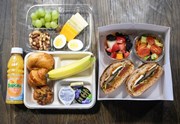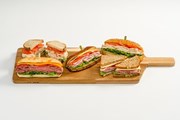Office Lunch Catering Options
Types of Catering Services
When organizing office lunches, it is essential to consider the various types of catering services available to meet the diverse needs of your team. One common option is drop-off catering, where the caterer delivers the food to your office and sets it up for self-service. This type of service is convenient for casual or informal gatherings. Buffet-style catering allows employees to serve themselves from a selection of dishes set up in a designated area. This option provides flexibility in choosing menu items and portion sizes.
For a more formal setting, plated catering service may be suitable. With this option, individual meals are plated and served to each guest, creating a more refined dining experience. If you're looking for a more interactive and engaging catering experience, food truck catering can add a fun and dynamic element to your office lunch. Food trucks offer a variety of cuisines and the novelty of watching your meal being freshly prepared on-site.
Another option to consider is a catering service that provides themed menus or specialty cuisines. This can add excitement and variety to your office lunches, catering to different preferences and dietary restrictions within your team. Understanding the different types of catering services available allows you to select the most suitable option based on the nature of your event, the preferences of your employees, and the overall ambiance you wish to create during office lunches.
When considering different types of catering services for office lunches, it is important to evaluate their benefits and drawbacks to make an informed decision. One common option is to use external catering companies, which can provide a wide range of menu choices and handle all aspects of food preparation and delivery. The benefit of this approach is convenience and professionalism, as these companies specialize in providing high-quality food for large groups. However, the drawback may be the higher cost associated with outsourcing catering services, especially for regular office lunches.
Another option is in-house catering, where companies have their own dedicated kitchen staff to prepare meals onsite. The benefit of in-house catering is greater control over the menu, allowing for more customization and flexibility to accommodate specific dietary needs or preferences of employees. Additionally, it can potentially be more cost-effective in the long run. However, drawbacks may include the need for additional equipment and resources, as well as the requirement for skilled kitchen staff to manage meal preparation efficiently.
A third alternative is the use of meal delivery services or meal kit subscriptions for office lunches. These services offer pre-portioned ingredients and recipes for easy preparation in the office kitchen. The benefit of meal kits is the convenience and variety they offer, as well as the potential for cost savings compared to traditional catering options. On the other hand, drawbacks may include limited menu choices, potential for food waste from unused ingredients, and the need for designated kitchen space for meal preparation.
In summary, each type of catering service has its own set of benefits and drawbacks that should be carefully evaluated based on factors such as budget, dietary considerations, and employee preferences. By weighing these factors and considering the specific needs of the office, you can choose the catering option that best suits your requirements for successful office lunch catering.
Factors to Consider When Choosing a Caterer
Price considerations are a crucial aspect to keep in mind when selecting a catering service for office lunches. Setting a budget beforehand can help in narrowing down options and ensuring that the chosen service aligns with financial constraints. It is essential to inquire about the pricing structure of different caterers, including whether they offer packages or à la carte options. Some caterers may have minimum order requirements or additional fees for delivery, setup, and service, which should be factored into the overall cost.
While it can be tempting to opt for the least expensive option, it is essential to balance cost with quality. Cheaper catering services may compromise on the quality of ingredients or presentation, which can impact the overall experience for employees. Evaluating the value proposition of each caterer, considering factors such as portion size, variety, and overall satisfaction, can help in making an informed decision.
Additionally, transparency in pricing is crucial. Ensure that the caterer provides a detailed breakdown of costs, including any potential extra charges, so there are no surprises when the final bill arrives. Some caterers may offer discounts for large orders or regular clients, so exploring these options can lead to cost savings in the long run.
Lastly, while price is an important consideration, it should not be the sole determining factor. It is essential to weigh price considerations alongside the quality of food, service reliability, and overall customer experience. By carefully evaluating price considerations in relation to other factors, such as menu variety and customer reviews, you can choose a catering service that aligns with your budget while also meeting the needs and expectations of your office lunch attendees.
Quality of food and service is a crucial factor to consider when choosing a catering option for office lunches. Ensuring that the food provided is of high quality is essential to leave a positive impression on employees and guests. High-quality food not only tastes better but also reflects well on the company hosting the event. Fresh ingredients, attention to detail in preparation, and skilled culinary techniques all contribute to the overall quality of the food.
Moreover, the level of service provided by the caterer is equally important. A professional and efficient service can enhance the overall dining experience for everyone involved. From the initial communication and planning stages to the setup, service, and cleanup, every aspect of the catering service should be executed with excellence. Courteous and attentive staff members can make a significant difference in how the lunch event is perceived by attendees.
When evaluating the quality of food and service offered by a catering company, it is advisable to read reviews and seek recommendations from previous clients. Positive feedback from other customers can provide insights into the caterer's reliability, consistency, and customer satisfaction levels. Additionally, requesting a tasting session or sample menu can help gauge the quality of the food firsthand and determine if it aligns with the expectations and preferences of the office.
Choosing a catering service that prioritizes both exceptional food quality and exemplary service can contribute to a successful and enjoyable office lunch event. By investing in a caterer that values these aspects, companies can ensure that their employees are treated to a memorable dining experience that reflects positively on the organization as a whole.
When considering a catering service for office lunches, reviews and recommendations play a crucial role in ensuring a positive experience. Reviews provide valuable insights into the quality of food and service offered by a caterer. By reading reviews from previous clients, you can gauge the reliability and professionalism of the catering company. Look for consistent positive feedback on aspects such as food taste, presentation, timeliness, and customer service.
Furthermore, recommendations from colleagues or other businesses can also be highly informative. If someone you trust had a great experience with a particular caterer, it can instill confidence in your choice. Asking for referrals from other professionals in your network can lead you to reliable catering services that have a track record of success.
Be mindful of both positive and negative reviews when evaluating catering options. While a few negative reviews are common for any business, pay attention to recurring issues or red flags that may indicate potential problems. Balance online reviews with personal recommendations to form a comprehensive view of the catering company's reputation.
In summary, reviews and recommendations are valuable resources that can guide you in selecting the right catering service for your office lunches. By leveraging feedback from others who have firsthand experience with the caterer, you can make an informed decision that aligns with your expectations and ensures a successful dining experience for your team.
Customization options play a crucial role in ensuring that the office lunch catering experience meets the specific needs and preferences of the employees. When choosing a caterer, it is essential to inquire about the level of customization they offer. Some caterers may provide the flexibility to tailor the menu according to dietary restrictions, allergies, or cultural preferences within the office.
Customization options also allow for the creation of a more personalized and memorable dining experience. For example, being able to select individual components for sandwich or salad stations can cater to varying tastes and dietary requirements among employees. Moreover, customization can extend to accommodating requests for specific ingredients, portion sizes, or even presentation styles.
By leveraging customization options, businesses can demonstrate their commitment to employee satisfaction and well-being. When employees feel that their dietary needs and preferences are taken into consideration during office lunch catering, it fosters a sense of inclusivity and appreciation within the workplace. Ultimately, a caterer that offers robust customization options can contribute to a successful and enjoyable office lunch experience for all participants.
Tips for a Successful Office Catered Lunch
Planning ahead and communicating with the caterer is crucial for a successful office catered lunch. Before the event, it is important to establish a clear timeline with the caterer, discussing the delivery time, set-up requirements, and any specific instructions for the food presentation. Providing the caterer with the number of guests, dietary restrictions, and preferences well in advance allows them to prepare accordingly and ensures a smooth experience on the day of the event.
Effective communication also involves discussing the logistics of the catering service, such as the layout of the serving area, the availability of necessary equipment like chafing dishes or serving utensils, and any special requests or accommodations required. Clarifying payment terms, including any additional charges for extra services or menu upgrades, helps prevent any misunderstandings later on.
Moreover, keeping an open line of communication with the caterer allows for flexibility in case of last-minute changes or adjustments to the menu or guest count. Being transparent about your budget constraints or specific goals for the office lunch helps the caterer tailor their services to meet your needs effectively.
Regular follow-ups with the caterer leading up to the event date ensure that both parties are on the same page and that all details are confirmed. Providing feedback after the office lunch catering can help improve future experiences and strengthen the relationship with the caterer for potential collaborations. By proactively planning ahead and maintaining clear communication throughout the process, you can set the stage for a successful and stress-free office catered lunch.
Providing a variety of menu options is essential when it comes to accommodating different tastes during office catered lunches. Diversity in food choices ensures that all employees, with their varying preferences and dietary needs, can find something suitable and enjoyable to eat. By offering a range of options, such as vegetarian, vegan, gluten-free, and meat-based dishes, you can cater to a wider audience and make everyone feel included.
When selecting catering menu items, consider offering a mix of cuisines and flavors to appeal to diverse palates. Including items like pasta dishes, stir-fries, salads, wraps, and soups can provide a good balance between light and more substantial meal choices. Additionally, incorporating a variety of proteins, such as chicken, beef, tofu, and seafood, can cater to different dietary requirements and taste preferences.
Moreover, integrating a combination of traditional and contemporary dishes can add an element of excitement and intrigue to the office lunch experience. Experimenting with different flavors, textures, and presentation styles can make the meal more engaging and enjoyable for employees. It is also beneficial to rotate menu options regularly to prevent monotony and keep the lunch offerings fresh and enticing.
Furthermore, gathering feedback from employees about their food preferences and previous catering experiences can help guide your menu planning decisions. Conducting surveys or informal discussions to understand what types of dishes and cuisines employees enjoy can assist in creating a well-rounded menu that caters to diverse tastes. Additionally, being open to suggestions and accommodating special requests can enhance the overall dining experience and show employees that their opinions are valued.
In conclusion, providing a variety of food options is crucial for accommodating different tastes during office catered lunches. By offering a diverse selection of menu items, considering dietary restrictions, and seeking feedback from employees, you can create a lunch experience that is enjoyable, inclusive, and satisfying for everyone involved.
Gathering feedback from employees plays a crucial role in making informed decisions for future office catering arrangements. By actively seeking and considering the input of the individuals who will be enjoying the meals, employers can ensure that the catering service aligns with the preferences and dietary requirements of the team. This feedback can encompass various aspects, including the selection of menu items, presentation, portion sizes, quality of food, and overall satisfaction with the service provided.
Implementing a system for collecting feedback, whether through surveys, suggestion boxes, or direct conversations, demonstrates a commitment to meeting the needs of employees and fostering a positive work environment. By analyzing the feedback received, employers can identify patterns, preferences, and areas for improvement. For example, if a significant portion of the team expresses a desire for more vegetarian options or healthier choices, this information can guide future menu planning to better cater to these preferences.
Moreover, gathering feedback creates a sense of inclusivity and empowerment among employees, as they feel their opinions are valued and taken into consideration. This can contribute to higher morale and engagement within the workplace, as individuals appreciate the effort to accommodate their needs and preferences. Employees are more likely to feel satisfied and appreciative when their voices are heard, creating a positive atmosphere surrounding office lunch catering events.
Incorporating employee feedback into the decision-making process for office catering can lead to more successful and enjoyable dining experiences for everyone involved. By leveraging the insights and suggestions provided by employees, employers can make well-informed choices that cater to a diverse range of tastes and preferences. Ultimately, prioritizing feedback fosters a collaborative and inclusive approach to office lunch catering, enhancing employee satisfaction and productivity in the workplace.




